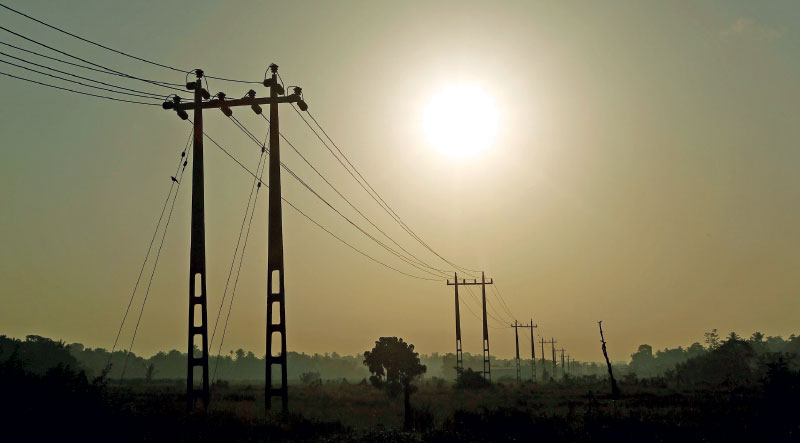Friday Oct 10, 2025
Friday Oct 10, 2025
Friday, 10 October 2025 05:29 - - {{hitsCtrl.values.hits}}

Sri Lanka’s electricity sector stands at a crossroads. The 2024 Act offered a path toward modernisation, private investment, and fiscal sustainability. The 2025 amendments reflect a retreat into familiar—but flawed—territory. This is not a debate between privatisation and public ownership. It is a question of whether Sri Lanka can deliver reliable, affordable, and sustainable power in a constrained fiscal environment. Whether ideology will trump pragmatism. And whether the CEB can survive without the very reforms it is resisting.
 The stakes are high. Electricity is not just a utility, it is the backbone of economic recovery, industrial growth, and climate resilience. Sri Lanka cannot afford to get this wrong.
The stakes are high. Electricity is not just a utility, it is the backbone of economic recovery, industrial growth, and climate resilience. Sri Lanka cannot afford to get this wrong.
Over the past two years, Sri Lanka’s electricity sector has transitioned from a period of reform-driven ambition to reverting to centralisation. The Ceylon Electricity Board (CEB)—long burdened by inefficiency, debt, and political inertia—was poised for transformation under the 2024 Electricity Act No. 36. But the 2025 amendments passed by the National People’s Power (NPP) Government have reversed course, reasserting state control and raising urgent questions about the sector’s future viability.
The CEB is a massive corporation with 2024 revenues of Rs. 547 billion (~$ 1.8 billion). It rivals corporate giants like MAS, Brandix, Hayleys and John Keells. But, until IMF Extended Fund Facility (EFF) program imposed a requirement for cost reflective tariffs, CEB was frequently loss making with cumulative losses from 2004 to 2024 of about Rs. 427 million (see Figure 1).
But this is not just a story about electricity or a large public sector corporation. It’s about a crucially important energy source. It is about whether Sri Lanka can modernise its infrastructure, attract investment, and deliver reliable, sustainable and lower cost power without repeating the mistakes of the past.
The 2024 Electricity Act No. 36: A market-oriented blueprint
The 2024 Electricity Act represented a significant initiative to restructure the CEB and liberalise the electricity market to enable delivery of cost-effective and reliable electricity in a sustainable manner. The Act sought to facilitate increased private sector participation and investment in the sector, addressing longstanding inefficiencies and underinvestment within these areas. The Act proposed:
1. Unbundled CEB into Independent Corporate Entities by splitting the CEB into distinct entities to improve competition, efficiency and transparency:
2. Established a Wholesale Electricity Market in a phased rollout, allowing generators and distributors to transact through transparent bidding and contracts, with the Public Utilities Commission of Sri Lanka as regulator.
3. Created a National Electricity Advisory Council as a statutory body with institutional independence, intended to provide broad-based, expert advice on electricity policy and regulation.
4. Encouraged open access and private sector participation
5. Established a National System Operator (NSO) responsible for real-time dispatch, grid management, scheduling and balancing, and overseeing bulk transactions between generators and distributors.
6. Provided a transition plan and employee protections
Sri Lanka Electricity (Amendment) Act, No. 14 of 2025: Ideology over investment?
The NPP Government’s amendments reflect a different vision—one rooted in centralised control, public ownership, and cautious reform. The Sri Lanka Electricity (Amendment) Act, No. 14 of 2025 introduced several consequential changes that significantly altered the reform trajectory set by the Electricity Act No. 36 of 2024. Here are the most impactful changes:
1.Structural reversal and governance centralisation
2.Ownership and licensing restrictions
3.Fragmentation instead of functional unbundling
4.Shift in dispatch philosophy
5.Policy realignment
Entrenched benefits: Ring-fencing inefficiency
Perhaps most tellingly, the 2025 Act seems to ring-fence the generous salaries, allowances, and overstaffing that have long characterised the pre-reform CEB. These protections—while politically aligned with the NPP Government—undermine the very efficiencies that greater private sector participation could have delivered under the 2024 framework. The NPP Government has signalled its intention to sign a collective agreement that will also bind the successor companies to guaranteeing several existing benefits and processes.
It is perfectly understandable that CEB employees would do their utmost to preserve the benefits they have enjoyed. Any workforce would. But it is the role of Government to act in the interest of all Sri Lankans—not just one segment. Protecting entrenched privileges at the expense of national progress is a short-sighted bargain.
Table 1 shows CEB’s productivity is similar to some Indian utilities but lags East Asian ones, while its salary costs are higher than those of its peers.
Financing in a post-reform landscape
Here lies the paradox. The 2025 Act reinforces state control—but under the IMF agreement, the government ability is constrained to offer sovereign guarantees or expand public borrowing to fund CEB investments. The very tools that once sustained the CEB—Treasury bailouts, state-backed loans—are now effectively off the table.
The 2024 Act was designed precisely to address this constraint. By permitting private ownership in generation and distribution and in transmission, it aimed to attract capital without burdening the state. It offered a pathway for independent power producers, renewable developers, and distribution operators to invest, innovate, and expand the grid.
The CEB anticipates needing $5 billion in new capital investment up to 2044, compared to $1.2 billion in capital investment made in the preceding ten years. But, the 2025 amendments have made investment less attractive by limiting cross-ownership, tightening licensing, and increasing political oversight. With no sovereign guarantees or strong private involvement, the CEB now faces a shortage of capital.
What’s left on the table?
Ultimately, to effectively mobilise the required investment, the NPP Government will need to balance the constraints of the new legislative framework with innovative financing mechanisms, regulatory clarity, and a willingness to partner with both international and domestic stakeholders. There may be yet a few financing options:
Yet, unless bold reforms are enacted or the private sector is meaningfully brought into the fold, the sector risks remaining mired in chronic underinvestment and inefficiency. It will deter the vital capital essential for the nation’s progress. In such a scenario, it is ultimately Sri Lanka that will bear the cost.
References:
Sources for data in Table 1.
CEB Sales and Generation Data Book 2023. Retrieved from https://www.ceb.lk/front_img/img_reports/1727249407Sales_and_Generation_Data_Book_2023.pdf,
CEB Statistical Yearbook 2024. Retrieved from https://ceb.lk/front_img/img_reports/1751344341Statistical_Digest_2024.pdf
Ceylon Electricity Board. (2023). Annual Report 2023. Colombo: CEB. Retrieved from https://www.ceb.lk
Government of Tamil Nadu. (2024). Energy Department Performance Budget 2024–25. Chennai: Government of Tamil Nadu. Retrieved from https://cms.tn.gov.in
IMF. (2025). World Economic Outlook: October 2025 Edition. Washington, DC: International Monetary Fund. Retrieved from https://www.imf.org/en/Publications/WEO
Kerala State Electricity Board. (2023). Budget and Performance Report 2023–24. Thiruvananthapuram: KSEB. Retrieved from https://ksebl-_budget-2023-24.pdf.
National Audit Office – CEB Audit 2023/ Retrieved from https://auditorgeneral.gov.lk/web/images/audit-reports/upload/2023/State-Corporations/2-XXXVIII/Ceylon-Electricity-Board-and-its-Subsidiaries--E.pdf
NTPC Annual Report 2023. Retrieved from https://ntpc.co.in/sites/default/files/annual-report/complete-reports/Annual%20Report%202023-24.pdf
PLN Statistics Indonesia 2023. Jakarta: PLN. Retrieved from https://web.pln.co.id/
Tamil Nadu Generation and Distribution Corporation (TANGEDCO). (2023). Data Card 2023–24. Chennai: TNEB Ltd. Retrieved from https://tn.gov.in
TNB Integrated Report 2023. Kuala Lumpur TNB. Retrieved from https://www.tnb.com.my/annualreport2023/images/downloads/TNB-IAR23.pdf
World Bank. (2024). Purchasing Power Parity Conversion Factors. Washington, DC: World Bank Group. Retrieved from https://data.worldbank.org
(The writer holding a PhD, is a former World Bank Lead Energy Specialist.)